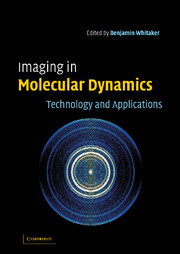Book contents
- Frontmatter
- Contents
- List of contributors
- Preface and acknowledgements
- List of abbreviations
- Part 1 Technology
- 1 Charged particle imaging in chemical dynamics: an historical perspective
- 2 Velocity map imaging: applications in molecular dynamics and experimental aspects
- 3 Reconstruction methods
- 4 Orientation and alignment
- 5 Time resolved cameras
- 6 3-D Imaging technique – observation of the three-dimensional product momentum distribution
- 7 Photoelectron and photoion imaging with femtosecond pump-probe time clocking
- Part 2 Applications
- Index
7 - Photoelectron and photoion imaging with femtosecond pump-probe time clocking
Published online by Cambridge University Press: 07 August 2009
- Frontmatter
- Contents
- List of contributors
- Preface and acknowledgements
- List of abbreviations
- Part 1 Technology
- 1 Charged particle imaging in chemical dynamics: an historical perspective
- 2 Velocity map imaging: applications in molecular dynamics and experimental aspects
- 3 Reconstruction methods
- 4 Orientation and alignment
- 5 Time resolved cameras
- 6 3-D Imaging technique – observation of the three-dimensional product momentum distribution
- 7 Photoelectron and photoion imaging with femtosecond pump-probe time clocking
- Part 2 Applications
- Index
Summary
Introduction
One of the most exciting advances in chemical physics in recent years has been the emergence and development of femtochemistry. This has been brought about largely because of advances in ultrafast laser technology, particularly the discovery of self-mode locking in Ti:sapphire and the development of chirped pulse or regenerative amplifiers. Another important innovation has been the development of a variety of linear and nonlinear spectroscopic techniques to probe electronic and nuclear dynamics. Nonlinear methods have been particularly useful in the study of solvation dynamics in the condensed phase. In the gas phase, where the density of molecules is much lower, ionization techniques such as pump-probe mass spectrometry have more often been employed. However, mass spectrometry can only provide the time-dependent population of a chemical species, in other words, kinetic information. In order to extract more detailed information on the reaction dynamics, measurements of the velocity vectors of the photoelectrons and fragment ions produced upon ionization are required. As we have seen in the preceding chapters, an imaging detector placed at the end of a time-of-flight mass spectrometer can easily accomplish such measurements. In this chapter we explore how ultrafast lasers can be coupled with charged particle imaging to develop experimental probes of ultrafast dynamic processes in molecules, such as electronic dephasing (radiationless transitions) and intramolecular vibration energy redistribution (IVR).
- Type
- Chapter
- Information
- Imaging in Molecular DynamicsTechnology and Applications, pp. 165 - 186Publisher: Cambridge University PressPrint publication year: 2003

